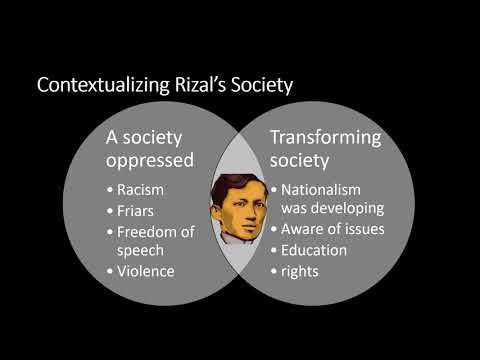RIPH & COLONIAL PHILIPPINES I || LESSON 3 || INITIAL ENCOUNTER AND SUBSEQUENT COLONIZATION
Summary
TLDRThis lesson explores the Spanish colonization of the Philippines, starting with Magellan's 16th-century expedition that initiated contact between Spaniards and proto-Filipinos. It details subsequent Spanish attempts to establish control, culminating in Miguel López de Legazpi's successful establishment of a Cebu settlement in 1565, marking the beginning of 333 years of Spanish rule. The narrative also touches on the initial native responses to colonization and the cultural exchanges that took place.
Takeaways
- 🚢 Ferdinand Magellan's expedition in the 16th century marked the first encounter between Spaniards and the inhabitants of the Philippine archipelago.
- 🌊 After Magellan's voyage, several subsequent expeditions were sent by Spain to conquer the Philippines, with Miguel López de Legazpi successfully establishing a settlement in Cebu in 1565.
- 🏝 Magellan's fleet faced harsh conditions crossing the Pacific Ocean, with some crew resorting to eating leather to survive.
- 🗺️ The Strait of Magellan was discovered, connecting the Atlantic and Pacific Oceans, during Magellan's expedition.
- 🔱 Magellan's death occurred in the Battle of Mactan against Lapu-Lapu, who refused to submit to Spanish rule.
- 💔 The initial response of the natives to the Spaniards was mixed, with some welcoming them while others, like Lapu-Lapu, resisted.
- 🏰 Legazpi's expedition led to the establishment of the first Spanish settlement in Cebu, initiating the Spanish colonization of the Philippines.
- 📜 The Spanish sought to convert the natives to Catholicism, as evidenced by the baptism of Raja Humabon and his wife, who were given Christian names.
- 🛳️ The Victoria, one of the remaining ships from Magellan's fleet, completed the first circumnavigation of the Earth.
- ⚔️ Spanish colonization spread to other parts of the archipelago, including Luzon, with the capture of Manila in 1570.
Q & A
Who was Ferdinand Magellan and what was his role in the initial encounter between the Spaniards and the Philippines?
-Ferdinand Magellan was a Portuguese explorer and mariner who led the first expedition to the Philippine archipelago on behalf of Spain. His voyage resulted in the initial encounter between the Spaniards and the proto-Filipinos in the 16th century.
What significant event occurred during Magellan's expedition on October 21, 1520?
-On October 21, 1520, Magellan's expedition discovered a passage that connects the Atlantic Ocean with the Pacific Ocean, which is now known as the Strait of Magellan.
Why was the island of Guam initially called the 'Island of Thieves' by Magellan's crew?
-The island of Guam was initially called the 'Island of Thieves' because the natives stole a boat from the ship Trinidad during Magellan's expedition.
What happened to Magellan during the Battle of Mactan on April 27, 1521?
-During the Battle of Mactan on April 27, 1521, Magellan and his men were defeated by Lapu-Lapu's warriors. Magellan was hit by a poisoned arrow and later by bamboo lances and a javelin, which led to his death.
What was the outcome of the dinner invitation by Humabon to the remaining Spaniards after Magellan's death?
-The dinner invitation by Humabon turned into a treacherous act where 26 Spaniards were invited to his palace and were killed by the natives while they were eating.
How did the remaining crew of Magellan's expedition return to Spain?
-The remaining crew of Magellan's expedition returned to Spain by taking two different routes. Trinidad, commanded by Gomez de Espirerra, attempted to cross the Pacific again to reach Mexico, but was captured by the Portuguese. Victoria, commanded by Sebastian del Cano, sailed to Spain by crossing the Indian Ocean and the African coast, and successfully returned to Spain on September 6, 1522.
What was the significance of Miguel López de Legazpi's arrival in the Philippines in 1565?
-Miguel López de Legazpi's arrival in 1565 marked the beginning of the Spanish colonization of the Philippines. He established a colonial settlement in Cebu, which initiated the 333-year rule of the Spaniards in the country.
What was the policy used by Legazpi to attract native chieftains and expand Spanish influence?
-Legazpi used a policy of attraction to woo native chieftains, which involved forming alliances through blood compacts, offering protection, and converting them to Catholicism.
How did the Spanish colonization spread to Luzon, and what was the significance of the capture of Manila?
-The Spanish colonization spread to Luzon after Legazpi's forces captured Manila on May 19, 1571, without bloodshed, through diplomatic measures. The capture of Manila was significant as it marked the establishment of Manila as the capital of the Philippines, as proclaimed by Legazpi on June 24, 1571.
What was the role of the expeditions following Magellan's in the Spanish colonization of the Philippines?
-The expeditions following Magellan's, such as those led by Loaisa, Cabot, Saavedra, Villalobos, and Legazpi, were attempts to establish a permanent Spanish presence in the Philippines. These expeditions, despite facing various challenges, eventually led to the successful colonization and establishment of Spanish rule.
What was the 'Blood Compact' and how did it play a role in the initial Spanish colonization of the Philippines?
-The 'Blood Compact' was a ritual where participants cut their arms and mixed their blood as a symbol of friendship and alliance. It played a role in the initial Spanish colonization by forging alliances with local chieftains, such as Raja Humabon and Raja Tupas, which facilitated Spanish influence and control.
Outlines

此内容仅限付费用户访问。 请升级后访问。
立即升级Mindmap

此内容仅限付费用户访问。 请升级后访问。
立即升级Keywords

此内容仅限付费用户访问。 请升级后访问。
立即升级Highlights

此内容仅限付费用户访问。 请升级后访问。
立即升级Transcripts

此内容仅限付费用户访问。 请升级后访问。
立即升级浏览更多相关视频

Pre Colonial Philippines explained in 2 minutes

HIS007 Session 2

GE-PH: Explaining the Biases and Analyzing Magellan's Voyage Around the World by Pigafetta

DANILO GERONA: Magellan and the Battle of Mactan

Ferdinand Magellan and the Battle of Mactan

A BRIEF SUMMARY OF THE FIRST VOYAGE AROUND THE WORLD BY MAGELLAN BY ANTONIO PIGAFETTA
5.0 / 5 (0 votes)
